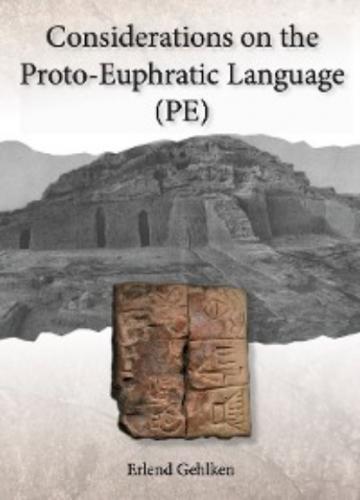Considerations on the Proto-Euphratic Language
1. Auflage, erschienen 4-2021
Umschlaggestaltung: Romeon Verlag
Text: Erlend Gehlken
Layout: Erlend Gehlken
ISBN: 978-3-96229-818-0
Copyright © Romeon Verlag, Jüchen (DE)
The work, including all its parts, is protected by copyright. Any use and reproduction of the work without the consent of the publisher is prohibited and punishable by law. All rights, including those of reprinting excerpts and translation, are reserved. The work, including parts thereof, may not be reproduced, transmitted or copied without the express written permission of the publisher. Violation obliges to compensation.
All information, results, etc. contained in the book have been prepared by the author to the best of his knowledge. They are provided without any obligation or guarantee on the part of the publisher. He therefore accepts no responsibility or liability for any inaccuracies that may exist.
Considerations on the Proto-Euphratic Language (PE)
A Daniela,
in ricordo del tempo trascorso insieme a Sanremo
CONTENTS
III.Writing, Vocabulary and Grammar
Various Types of Lists, Calculations, Festival Texts, Calendars, Field Texts, BA, GI & GU7, Additional Payment Notes
EN, ḪAL GAR, UB ŠÀ, Homophones, BA & GU7: c1/168 and c1/156
VI.“Non-Sumerian” Sign Combinations, Abandoned and Retained PE Signs, New Sumerian Readings
VII.Selected PE Personal Names
Words
1Akkadian
2Sumerian
3Proto-Euphratic (PE)
Non-PE Personal Names
Gods, Nature Spirits and Stars
Countries, Towns and Rivers
Temples and Other Buildings
Subjects
Literature
General Abbreviations
Conventions Used in the Transcriptions and Translations
PREFACE
One of the most important advanced civilisations of antiquity is to be found in Mesopotamia, a second one in Egypt. There may have been more ancient cultures, but they have not yet emerged from the mists of history. It goes without saying that this study refers to cultures that have developed a system of writing as we know it. The artists who created the paintings in the caves of Altamira, Lascaux or in the Maros-Pangkep Karst on Sulawesi were no less talented. The indigenous inhabitants of Mesopotamia are difficult to grasp as a people. In the north of the country, rain-fed agriculture was feasible, but not in the south. Accordingly, the south of the country was settled at a late stage. Nobody knows when and from where the Sumerians migrated to Mesopotamia.
No notable Assyriologist claims that the Sumerians were the first settlers in southern Mesopotamia, but almost all Assyriologists are of the opinion that the first settlers had not yet written down their language, the “Proto-Euphratic language” (henceforth PE; an artificial word). In general, the Sumerians and the Egyptians are considered to be the ones who, according to current knowledge, created the first writing systems. For Mesopotamia, one of the most prominent advocates of this opinion was the well-known Heidelberg Assyriologist Adam Falkenstein († 1966), who in 1936 was the first to publish a volume with archaic texts from the city of Uruk, from which the oldest written documents originate. His most prominent, albeit somewhat hesitant, “opponent” was Robert K. Englund († 2020), who wrote under the keyword “The 4th millennium” in the article “Uruk. A. I. Philologisch. 4.–3. Jahrtausend” in the “Reallexikon der Assyriologie” (vol. 14, published in fascicles 2014–2016): “The consensus among specialists is that the number of identified probable phonetic renderings of protocuneiform signs indicates that Sumerian was at least one of the languages employed by Late Uruk scribes (and by logical extension, the only one) (among many others, cf. Nissen 1999, 45f.; Cooper 2004; Krebernik 1994a; Rubio 2005). Englund (1998, 73–81; id. 2009, § 2.5) and Whittaker (2005) remain sceptical; s.a. the discussion in Sumer*, Sumerisch. § 6.”
This short study attempts to securely and sustainably validate the existence of a written form of the PE language. Almost all the material presented here has been published before. The aim of this publication is to gather the scattered published views so as to enable a better understanding of this discussion. Robert K. Englund’s investigation Texts from the Late Uruk Period in OBO 160/1, in which he presents and analyses the archaic text corpus of the Uruk period in an exemplary manner, remains fundamental.
This book is also addressed to the interested lay person. For this reason, explanations that the specialist colleague must consider superfluous have often been given. The appendix “Cuneiform Script” has been added for orientation.
My sincere thanks go to ROMEON Verlag (Kaarst, Germany) for publishing this study. The beneficial and cooperative collaboration – especially with the Creative Director, Mr Christian Türling – as well as the pleasing presentation of the book speak for themselves. My special thanks are due to Mr Derek O’Brien (University
